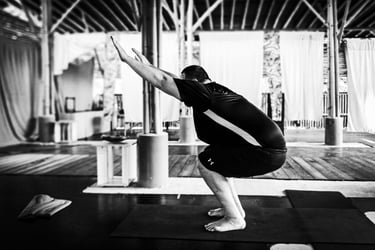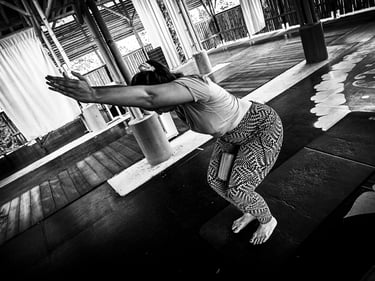Chair Pose for Whole Body Engagement
Chair Pose demands significant effort, engaging key muscle groups across the body to maintain balance and alignment. While the lower body does the bulk of the work, the core, back, and upper body also contribute.
Specifically:
The muscles at the front of the thighs (quadriceps) work hard to support the body’s weight.
The muscles at the back of the thighs (hamstrings) assist in stabilising the knees and hips.
The gluteal muscles (buttocks) engage to stabilise the hips and pelvis.
The calf muscles help maintain balance in the lower legs.
The core muscles are activated to support the torso and maintain posture.
A group of muscles in the back work to keep the spine elongated and upright.
The muscles of the upper arms and around the shoulder joints engage as the arms are extended overhead.
The muscles around the ankles stabilise to maintain balance.


The term "Utkatasana" translates to "Fierce Pose" in Sanskrit but is commonly translated as "Chair Pose" for the shape the body takes . The word "utkata" means "powerful" or "intense," which reflects the strength and focus required to hold this posture.
Although Chair Pose primarily strengthens the lower body, it also enhances awareness of muscle engagement throughout the back, fostering a deeper sense of balance and stability.
This heightened awareness of muscle engagement throughout the pose is a practical way to deepen interoception (knowing what's happening in your body), as it helps practitioners 'listen' to their bodies on a more subtle level.


Its focus on alignment and stability makes it an ideal inclusion in our Gentle Standing Sequence.
More Insights
